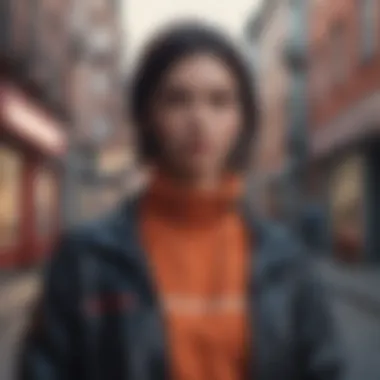Uncovering Alternative Fashion Brands Like The Ragged Priest


Intro
In recent years, streetwear and alternative fashion have garnered increased attention, captivating individuals who seek to express their identity through unique clothing. The Ragged Priest stands as an exemplar in this space, renowned for its striking styles and rebellious attitude. This article explores brands that exhibit similar characteristics and philosophies, delving into their design approaches, target demographics, and collaborations. Understanding these brands sheds light on the broader landscape of fashion that appeals to a diverse set of consumers.
The Ethos of Alternative Fashion
Alternative fashion is more than just clothing; it embodies a mindset, an ethos of individuality, and defiance against mainstream norms. Brands within this realm often draw inspiration from countercultural movements and subcultures. They tend to emphasize creativity, self-expression, and a non-conformist approach.
The Ragged Priest captures this essence well, infusing their collections with punk influences and bold designs that resonate with like-minded individuals. Brands that exist within this niche often share similarities in their production processes, sustainability initiatives, and community engagement.
Key Characteristics of Brands Like The Ragged Priest
When examining brands that reflect The Ragged Priest's characteristics, several key elements emerge:
- Design Philosophy: These brands frequently prioritize innovative designs that challenge conventional aesthetics. They cater to those who seek distinctiveness, with many opting for eclectic patterns and textures.
- Target Audience: The consumer demographic spans young adults to those who appreciate a nontraditional style. These brands commonly attract individuals seeking alternative fashion statements.
- Collaborative Endeavors: Many fashion brands engage in collaborations with artists, designers, or influencers, creating limited-edition pieces that heighten their appeal.
"Fashion is about seeking your own identity and leaving an impact."
Notable Brands to Explore
In the examination of brands akin to The Ragged Priest, several names stand out:
- Lazy Oaf: Known for playful graphics and quirky designs, Lazy Oaf embodies a fun take on streetwear.
- Drole de Monsieur: This brand emphasizes a mix of luxury and casual wear, appealing to those who appreciate a laid-back yet stylish aesthetic.
- Ader Error: With a unique mix of street culture and high fashion, Ader Error challenges traditional fashion norms through its innovative designs.
As we journey through the diverse landscape of fashion, it becomes vital to understand the cultural significance and individual narratives presented by these brands. Evaluating their impact and appeal not only informs consumers but also encourages a more profound appreciation for alternative fashion as a whole.
The Essence of Alternative Fashion
The realm of alternative fashion serves as a critical element in the broader landscape of fashion. It challenges traditional norms and expectations, allowing for the expression of individuality and creativity. This concept becomes particularly relevant when exploring brands like The Ragged Priest, as such brands typically embody values that resonate deeply with consumers seeking to break away from mainstream aesthetics.
Alternative fashion embraces diversity in styles that often mirror subcultures. For many, it is a means of identity, a way to signal belonging to a particular group that values uniqueness over conformity. This tension between personal expression and societal norms highlights the importance of alternative fashion. Consumers are not just looking for clothing; they seek garments that speak to their beliefs, lifestyles, and aesthetics.
Furthermore, alternative fashion often examines and critiques present consumer behaviors and societal issues. It encourages consumers to think critically about what they wear. By focusing on sustainability and ethical practices, brands can cultivate a loyal customer base. These brands often appeal to a demographic that values mindfulness and intentional consumerism.
In addition, alternative fashion offers a platform for boundary-pushing designs and innovative collaboration, allowing emerging brands to grow alongside established names. The creative partnerships within this space can yield inspiring collections that elevate the overall discourse in the fashion industry.
Key Considerations
- Alternative fashion provides a voice to diverse expressions of style.
- It acts as a critique of consumerism by promoting sustainability and ethical production.
- Collaborations within this niche lead to unique and inspiring designs, enriching consumers’ choices.
In summary, the essence of alternative fashion transcends mere clothing, representing a movement steeped in cultural significance and personal identity. Understanding this foundation is vital as we move to examine brands like The Ragged Priest and others that echo similar values.
Understanding The Ragged Priest
To comprehend the significance of The Ragged Priest within alternative fashion, it is crucial to delve into its brand history and philosophy. This brand emerges not merely as a clothing line but as an essential voice in defining what alternative fashion signifies today. Recognizing its unique approach provides insight into the broader context of the fashion landscape, particularly how it resonates with consumers looking for authenticity and self-expression.
Brand History and Philosophy
The Ragged Priest began in the UK and quickly became recognized for its distinctive aesthetic that merges punk, streetwear, and a hint of rebellious attitude. Founded by a group of creative designers, the brand established itself in the early 2010s, riding the wave of a growing demand for styles that departed from mainstream trends. Their core philosophy emphasizes individuality and the idea that clothing should reflect a person's identity rather than conform to rigid societal expectations.
Each piece tells a story, engaging the wearer in a narrative that champions self-expression. The brand’s commitment to creating unique, stand-out pieces speaks to its foundation in alternative culture. Furthermore, the focus on upcycling and sustainability aligns with contemporary values, making The Ragged Priest not just a brand but a movement.


Signature Styles and Offerings
When examining The Ragged Priest, one must note its signature styles that consistently attract a dedicated following. The designs often incorporate oversized fits and playful graphics, combining elements of grunge and vintage aesthetics. Clothes are intentionally distressed, echoing themes of rebellion while appealing to the youth culture. Unique offerings include everything from acid-wash denim jackets to oversized graphic tees that serve as both statement pieces and instances of wearable art.
The color palette typically includes daring combinations that elevate the designs from ordinary to extraordinary. Layering is a key concept; outfits encourage mixing and matching, allowing individuals to form personal styles that reflect their personalities. Moreover, The Ragged Priest often collaborates with various influencers and artists, adding an eclectic touch that emphasizes community and creativity.
Key Competitors in the Market
The landscape of alternative fashion is marked by numerous brands that capture the essence of individuality and self-expression, much like The Ragged Priest. Understanding these key competitors is essential because it allows consumers to make informed choices and appreciate the broader context of their fashion selections. Each brand contributes a distinct identity to the market, enriching the diversity that defines alternative fashion. Knowing what sets these brands apart can enhance one’s wardrobe with unique pieces that reflect personal style and beliefs.
Analyzing Contemporary Brands
Unique Selling Propositions
The Unique Selling Proposition (USP) of a brand is what makes it stand out from others in the fashion industry. In the context of brands similar to The Ragged Priest, a strong USP can be informed by factors like authenticity and innovative design. Brands often emphasize their commitment to inclusivity or sustainable practices as a primary selling point. This characteristic can resonate well with consumers who value ethical fashion choices.
For instance, one notable feature of a brand's USP could be its dedication to limited-edition runs that foster exclusivity. This strategy often appeals to a niche audience that seeks unique items that represent individuality. The advantage of a strong USP is that it cultivates brand loyalty, driving customers back for distinctive offerings.
Market Positioning
Market Positioning refers to how a brand is perceived in relation to its competitors. Brands that mirror The Ragged Priest often position themselves within the realm of streetwear or alternative fashion, targeting a demographic that prioritizes style over conventional norms. A key characteristic of effective market positioning is a clear understanding of the target audience. This enables brands to tailor their marketing strategies to resonate with specific consumer preferences.
One unique feature of successful market positioning is how a brand leverages social media engagement and collaborations with influencers. This can strengthen its presence within the competitive landscape. However, excessive reliance on trends can be a disadvantage, as it may alienate loyal customers looking for genuine and lasting styles.
Comparative Analysis
Design Differences
Design differences among brands targeting the alternative fashion scene are crucial. Varied aesthetics in cuts, colors, and patterns provide consumers with a rich array of choices. A notable characteristic here is the blend of punk, vintage, and modern elements that many brands incorporate. This ability to create a hybrid style is often a beneficial aspect that attracts diverse customer bases.
For example, a brand might emphasize asymmetrical cuts and bold prints, catering to those who seek avant-garde fashion. These unique design features can enhance a consumer's wardrobe by incorporating pieces that epitomize self-expression. However, the challenge lies in balancing uniqueness with wearability, as overly artistic designs may not appeal to all.
Consumer Appeal
Consumer appeal within this market segment is influenced by several factors, including brand story, lifestyle alignment, and product variety. A key characteristic that enhances consumer appeal is authenticity, which can draw consumers in seeking brands that they feel are genuine.
Many brands succeed in this area by sharing their stories and values with their audiences, establishing a connection. One unique feature of successful brands is their ability to create communities around their products, encouraging customer loyalty. However, brands must be mindful; as the market grows, staying connected with consumers becomes increasingly essential to avoid losing touch with their core audience.
Emerging Brands That Resonate
The significance of emerging brands in the alternative fashion landscape cannot be understated. These brands not only challenge conventional norms but also reflect the evolving tastes and values of modern consumers. In exploring brands that resonate with The Ragged Priest's ethos, we find that emerging labels often bring fresh perspectives, innovative designs, and a commitment to sustainability that appeals to a generation seeking authenticity and expression in their fashion choices.
As consumers become more discerning, they look for brands that align with their personal values. Emerging brands tend to position themselves with a clear identity, making them appealing to niche audiences. They foster a sense of community among their patrons, encouraging self-expression while pushing the boundaries of traditional fashion. This section delves into three specific brands that exemplify these qualities.
Brand A: Identity and Offerings
Brand A stands out due to its unapologetic representation of alternative culture. Its identity revolves around self-expression, inclusivity, and unconventional aesthetics. The logo is bold, and their marketing visuals reflect an edgy, rebellious spirit. They offer a range of products, from oversized prints to statement accessories. Each item feels curated rather than mass-produced, which enhances its appeal.
Their seasonal collections often draw inspiration from subcultures, and they collaborate with artists and musicians to create limited edition pieces. This collaboration reinforces their identity while offering consumers something unique. The focus on individuality makes Brand A popular among those who prioritize personal style over conformity.
Brand B: Craftsmanship and Design
Craftsmanship is at the heart of Brand B's offerings. Every piece is meticulously designed, emphasizing quality over quantity. This brand takes pride in using sustainable materials and ethical practices. Their attention to detail is evident in stitching and finishing, which can be rare in the fast-fashion industry.


In terms of design, Brand B merges functionality with aesthetics. Their garments often feature utility elements, such as pockets and adjustable fittings, appealing to consumers who seek practicality without sacrificing style. This blend of craftsmanship and thoughtful design resonates with a discerning audience that values not just what they wear but also how it is made.
Brand C: Target Demographics
Brand C has a clear vision of its audience. They primarily target young adults who embrace alternative lifestyles. The demographic often includes individuals who align with specific subcultures and appreciate the brand's commitment to authenticity. This brand engages with its community through social platforms, showcasing real customers and their stories.
The marketing strategy relies on relatable imagery and narratives, which helps forge a connection with potential customers. By understanding their audience, Brand C tailors its product offerings to meet their needs, from streetwear staples to festival-ready outfits. This tailored approach ensures strong loyalty from its customer base, who feel represented and valued.
Emerging brands are vital in reshaping the fashion narrative. They challenge the status quo and inspire consumers to embrace their individuality.
Collaborations and Partnerships
Collaborations and partnerships play a crucial role within the landscape of alternative fashion, particularly for brands like The Ragged Priest. These alliances can amplify brand visibility and enhance creative expression. They allow brands to tap into new markets and consumers, broadening their reach beyond traditional boundaries. Collaborations often bring together diverse aesthetics and ideologies, creating unique products that stand out in an oversaturated market.
Furthermore, these partnerships can infuse fresh perspectives, merging different brand identities and cultures. The process encourages innovation, allowing brands to experiment more freely with designs and textiles. Ultimately, the right collaboration can lead to increased sales and stronger customer loyalty, as consumers are drawn to the exclusivity and creativity of such projects.
Influential Collaborations in the Alternative Scene
The alternative fashion scene has seen various influential collaborations that have helped shape its current landscape. Notable partnerships include collaborations between streetwear brands and high-fashion labels, resulting in a fusion of styles that attracts a wider audience. For example, the collaboration between Supreme and Louis Vuitton created a buzz that reverberated throughout fashion circles, bringing streetwear into luxury retail spaces.
Another significant collaboration is between Adidas and Y-3. This partnership blends sportswear with avant-garde design, showcasing how alternative brands can innovate within traditional frameworks. These collaborations not only produce limited-edition items that attract collectors but also highlight the evolving nature of fashion. Brands that engage in such partnerships often do so to capture the essence of youth culture, which values individuality and originality.
"Collaborations can redefine the marketplace, creating opportunities for brands to position themselves as trendsetters."
Impact on Brand Identity
The impact of collaborations on brand identity cannot be understated. Each partnership shapes how a brand is perceived in the marketplace. When a brand collaborates with another, it often adopts elements from the partner's philosophy and aesthetics. This can either enhance its original identity or lead to a complete rebranding.
For instance, brands that align with sustainability often collaborate with eco-friendly organizations. These partnerships emphasize their commitment to ethical practices and attract conscious consumers. In contrast, partnerships with music artists or cultural icons can infuse a vibrant energy into the brand, appealing to broader audiences with varied interests.
Sustainability and Ethics in Fashion
The fashion industry faces increasing scrutiny over its impact on the environment and society. This section highlights the significance of sustainability and ethics within the context of alternative fashion, particularly for brands similar to The Ragged Priest.
Sustainability goes beyond just eco-friendly materials. It encompasses the entire supply chain, including the ethical treatment of workers and the environmental footprint of production processes. Brands that embrace sustainable practices not only contribute to a healthier planet but also attract a conscientious consumer base that values responsibility.
The Shift Towards Sustainable Practices
In recent years, there has been a noticeable shift towards sustainable practices within the fashion industry. This change is largely driven by consumer demand for transparency and accountability. More shoppers are prioritizing brands that demonstrate ethical standards in production.
Some key contributors to this shift include:
- Innovative Materials: The use of organic cotton, recycled fabrics, and biodegradable options are gaining popularity.
- Reduced Waste: Brands are adopting practices like zero-waste design and upcycling. This minimizes the environmental impact.
- Fair Labor Practices: Transparency in labor conditions is becoming essential. Brands that ensure fair wages and safe working conditions are respected among consumers.
- Eco-Friendly Packaging: Sustainable packaging solutions are now a standard consideration. This includes reusable or recyclable materials.
Brands Leading the Change
Several brands are setting commendable examples in the commitment to sustainable and ethical fashion. They truly stand by their principles and inspire others.
- Patagonia: Known for its environmental activism, Patagonia emphasizes durability and repairability in its clothing. Its commitment to transparency has made it a role model in sustainable fashion.
- Everlane: This brand is dedicated to radical transparency. It openly shares production costs and factory conditions with consumers to establish trust and accountability.
- Reformation: Reformation focuses heavily on using sustainable materials and has a clear mission to reduce its carbon footprint.
- TOMS: While originally focused on footwear, TOMS has broadened its scope to include sustainable products. Its One for One model highlights social responsibility.
By prioritizing ethics and sustainability, these brands not only align with growing consumer values but also pave the way for a more responsible fashion industry.


"Sustainability in fashion is essential not only for the planet but also for the future of the industry itself."
Consumer Culture and Alternative Fashion
Consumer culture plays a crucial role in shaping alternative fashion. This atmosphere fosters a sense of community among individuals who seek unique identities and eschew mainstream trends. Understanding this culture offers insight into why brands like The Ragged Priest have emerged and thrived.
One primary aspect of consumer culture in alternative fashion is its focus on individuality. Consumers are not just purchasing clothing; they are making a statement about who they are. This push for self-expression means that brands must develop distinct aesthetics and narratives that resonate with their target audience. In this context, alternative fashion symbolizes not only style but also ideologies such as anti-conformity and creativity.
Another important element is the demographic influence, particularly from the Millennial and Gen Z cohorts. These generations prioritize brands that reflect their values, such as sustainability, inclusivity, and social responsibility. Consequently, many fashion labels have had to adapt to meet these expectations or risk losing relevance in a rapidly evolving marketplace.
The intersection of consumer culture and alternative fashion emphasizes the necessity for brands to engage with consumers authentically. This means that companies must invest in understanding their audience and tailor their products accordingly. The right balance between authenticity and marketability can significantly enhance a brand's appeal.
Moreover, brands often engage in storytelling, which aligns their offerings with the cultural narratives desired by their consumers. By doing so, they not only sell products but also invite consumers into a community with shared values. This engagement enhances brand loyalty while fostering a unique consumer experience that resonates deeply.
"The future of alternative fashion lies in understanding consumer desires and creating products that align with those aspirations."
In summary, consumer culture is an integral part of alternative fashion. It influences both brand strategies and consumer choices, shaping the landscape in which brands like The Ragged Priest operate.
Understanding the Millennial and Gen Z Consumer
The Millennial and Gen Z consumers are pivotal in alternative fashion’s continued evolution. Their collective mindset is defined by a desire for authenticity, inclusivity, and sustainability. This demographic does not simply follow trends; it actively shapes them.
Groundbreaking Characteristics of Millennials and Gen Z:
- Demand for Sustainability: Both generations express a strong preference for sustainable practices in clothing production, favoring brands that adopt eco-friendly processes.
- Social Conscience: There is a heightened awareness of social issues, leading consumers to support brands that engage in social justice or charitable initiatives.
- Digital Natives: With the rise of the internet, these consumers are accustomed to being online. They use social platforms not just for communication, but also for discovering trends and brands.
This generation tends to question traditional retail models. They seek experiences over mere products. Brands need to adapt to these changing preferences or face disengagement. Thus, it’s vital for alternative fashion labels to resonate with these values to appeal effectively to the Millennial and Gen Z consumers.
The Role of Social Media
Social media has transformed the landscape of alternative fashion. Platforms like Instagram, TikTok, and Pinterest serve as vital gateways for brand discovery and engagement. Brands can showcase their collections, tell stories, and interact with consumers directly.
Key impacts of social media on consumer behavior include:
- Instant Feedback: Brands receive immediate reactions to products and campaigns, allowing for quick adjustments to meet consumer demands.
- Micro-Influencers: These individuals have cultivated niche followings. Collaborating with them enables brands to reach specific audiences authentically.
- Visual Content: The fashion industry is inherently visual. Social media allows for striking imagery that promotes product desirability and fuels consumer aspiration.
Considerations for Brands:
- Develop a consistent online presence to maintain consumer interest.
- Invest in engaging content that resonates with the brand's identity and target audience.
- Utilize analytics to understand which strategies yield the best interaction and conversion rates.
Overall, social media is not just a marketing tool; it’s an essential component of the alternative fashion ecosystem. Brands that harness its potential can create strong connections with emerging consumers, fostering loyalty and community around their unique offerings.
Ending
The conclusion of this article serves to encapsulate the key points discussed throughout the exploration of brands akin to The Ragged Priest. It is crucial because understanding these brands helps to contextualize how they fit within the broader landscape of alternative fashion.
Summarizing Key Insights
In reviewing the brands highlighted, several notable themes emerge:
- Design Innovation: Each brand demonstrates a commitment to unique and innovative designs that appeal to a niche demographic. Their collections often blur traditional lines of fashion, resonating with consumers seeking individuality.
- Cultural Influence: Many of these brands draw inspiration from various cultural elements, making their clothing not just garments but statements that reflect lifestyle choices and personal values.
- Sustainability: More brands are incorporating sustainable practices into their production methods, responding to a growing demand for ethical consumption.
- Community Engagement: Engaging with the community through collaborations and local initiatives strengthens brand loyalty and enhances their visibility within the fashion scene.
These insights underline the shift towards an inclusive, innovative, and conscientious fashion landscape.
Future Trends in Alternative Fashion
As the alternative fashion space continues to evolve, several trends are becoming increasingly evident:
- Technology Integration: The use of technology in design and production processes will likely grow, with brands incorporating smart fabrics and digital patterns that redefine how clothing is produced and worn.
- Enhanced Personalization: Consumers are seeking personalized experiences. Brands that prioritize customization in their designs are poised to thrive.
- Focus on Sustainability: The trend towards eco-friendly materials and processes will remain strong. Brands will need to find more creative ways to market their sustainability efforts to appeal to ethically conscious consumers.
- Cultural Diversity: Expect greater representation in the design space, with brands reflecting diverse cultural backgrounds and perspectives in their offerings. This inclusivity creates a richer tapestry of fashion narratives.







